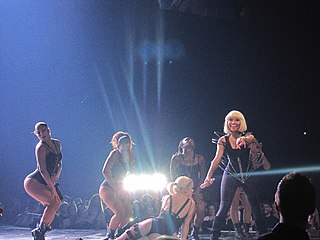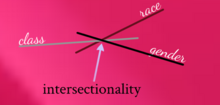
Intersectionality is a feminist analytical framework for understanding how groups' and individuals' social and political identities result in unique combinations of discrimination and privilege. Examples of these factors include gender, caste, sex, race, ethnicity, class, sexuality, religion, disability, height, age, weight, species and physical appearance. These intersecting and overlapping social identities may be both empowering and oppressing. However, little good-quality quantitative research has been done to support or undermine the practical uses of intersectionality.
Black feminism, also known as Afro-feminism chiefly outside the United States, is a branch of feminism that focuses on the African-American woman's experiences and recognizes the intersectionality of racism and sexism. Black feminism also acknowledges the additional marginalization faced by black women due to their social identity.

A video vixen is a female model who appears in hip hop-oriented music videos. From the 1990s to the early 2010s, the video vixen image was a staple in popular music, particularly within the genre of hip hop. The video vixen first came around in the late 1980s when the hip-hop culture began to emerge into its own lifestyle, although was most popular in American popular culture during the 1990s and 2000s. Many video vixens are aspiring actors, singers, dancers, or professional models. Artists and vixens have been criticized for allegedly contributing to the social degradation of black women. Latinas are also degraded and hyper-sexualized in hip hop music videos because they are seen as objects of sexual desire in rap music videos.
Sexualization is the emphasis of the sexual nature of a behavior or person. Sexualization is linked to sexual objectification, treating a person solely as an object of sexual desire. According to the American Psychological Association, sexualization occurs when "individuals are regarded as sex objects and evaluated in terms of their physical characteristics and sexiness." "In study after study, findings have indicated that women more often than men are portrayed in a sexual manner and are objectified. In addition, a narrow standard of physical beauty is heavily emphasized. These are the models of femininity presented for young girls to study and emulate."

Stereotypes of African Americans are misleading beliefs about the culture of people with partial or total ancestry from any black racial groups of Africa whose ancestors resided in the United States since before 1865, largely connected to the racism and the discrimination to which African Americans are subjected. These beliefs date back to the slavery of black people during the colonial era and they have evolved within American society.
Chickenhead is an American English slang term that is typically used in a derogatory manner toward women. The term mocks the motion of the head while performing oral sex on a man, but contains social characteristics and cultural relevance as well, and is frequently heard in popular hip hop music. More recent uses of the term have seen it taken back by hip hop feminists and entertainers as a symbol of sexuality and power. "Chickenhead" is also a term used in overseas sex trafficking for individuals that facilitate and monitor a person's transition into sex work.

Sexuality in music videos has been evident since the 1980s.
Misogyny in rap music refers to lyrics, videos, or other aspects of rap music that support, glorify, justify, or normalize the objectification, exploitation, or victimization of women. It is an ideology that portrays women as objects for men's ownership, use, or abuse. It diminishes women to expendable beings. It can range from innuendoes to stereotypical characterizations and defamations.
The representation of African Americans in speech, writing, still or moving pictures has been a major concern in mainstream American culture and a component of media bias in the United States.
Examples of misogyny exist in many published forms, within multiple cultures and well-observed works. Technological advances in the modern era have contributed proficient means to media and marketing to the resultant mass media in the 21st century. The merging of misogyny and mass media has made numerous examples where studies have concluded correlations between misogynous messages, both obvious and subliminal. Corresponding physical appearance of violence and hateful conduct may be seen relative to exposure.
Internalized sexism is a form of sexist behavior and attitudes enacted by women toward themselves or other women and girls. Internalized sexism is a form of internalized oppression, which "consists of oppressive practices that continue to make the rounds even when members of the oppressor group are not present." Internalized sexism can have a range of effects on women and girls such as problems with mental health and body image. Modes of internalization of sexism include early childhood inculturation and consumption of media, while language can also moderate power imbalances between groups and perpetuate internalized sexism.
The angry black woman stereotype is a racial trope in American society and media that portrays Black American women as inherently ill-mannered and ill-tempered.
Hip hop feminism is a sub-set of black feminism that centers on intersectional subject positions involving race and gender in a way that acknowledges the contradictions in being a black feminist, such as black women's enjoyment in hip hop music and culture, rather than simply focusing on the victimization of black women in hip hop culture due to interlocking systems of oppressions involving race, class, and gender.
In hip hop, the term mami refers to an attractive Latina woman, typically of Puerto Rican or Dominican descent. There is also the emergence of the mami video vixen, who is the glamorized, hyper-sexualized version of an attractive Latina woman that is seen in rap videos. The image of mami that is the most popular in rap culture is the butta pecan mami, a term coined by Raquel Z. Rivera, which refers to a Latina woman who has light golden colored skin and "good" (European-type) hair.
Feminist activism in hip hop is a feminist movement based by hip hop artists. The activism movement involves doing work in graffiti, break dancing, and hip hop music. Hip hop has a history of being a genre that sexually objectifies and disrespects women ranging from the usage of video vixens to explicit rap lyrics. Within the subcultures of graffiti and breakdancing, sexism is more evident through the lack of representation of women participants. In a genre notorious for its sexualization of women, feminist groups and individual artists who identify as feminists have sought to change the perception and commodification of women in hip hop. This is also rooted in cultural implications of misogyny in rap music.
Moya Bailey is an African-American feminist scholar, writer, and activist. She is noted for coining the term misogynoir, which denotes what Bailey describes as the unique combination of misogyny and anti-black racism experienced by black women. Bailey is an associate professor at Northwestern University.
Raunch aesthetics is a term in feminist theory which describes the ways in which women in hip hop express their sexuality through the performance of lyrics, choreography, and staging. These aesthetics are performed by artists such as Rihanna, Beyoncé, Ciara, Nicki Minaj, Megan Thee Stallion and Miley Cyrus with the intention to embrace and take control over their own bodies and sexual identities through verbal and physical expression.
The lack of respect that black women received in the music industry gave rise to hip-hop feminism, as singers such as Monie Love brought attention to the differences in acknowledgment that exist even for equal talent. The movement tackles problems arising from deindustrialization, racial wealth disparities, and conservative backlash. It was molded by the social environment of the 1980s and 1990s. Me'Shell Ndegeocello an American rapper, singer and bassist and Angie Stone a singer are two artists that have shaped the conversation. Hip-hop feminism goes beyond gender issues to support the rights of women, African Americans, and LGBTQ people. Prominent figure in the genre Queen Latifah used "the politics of respectability" to promote women's rights and racial empowerment. Ndegeocello is one of the rising queer feminists of color who brings a nuanced viewpoint to problems like abortion and unjust beauty standards. Changes in perspectives are reflected in the transition from male-dominated hip-hop to women-centered hip-hop soul, which allows for a diversity of narratives within black communities. The Grammy-winning song "U.N.I.T.Y." by Queen Latifah was a historic moment that validated the powerful voice of black women in a male-dominated field and sparked discussions about domestic abuse and the commodification of black women's sexuality.
The Strong Black Woman schema, as defined by scholars, is an archetype of how the ideal Black woman should act. This has been characterized by three components: emotional restraint, independence, and caretaking. Strong Black women must hold back their emotions to avoid appearing weak, portray themselves as strong and independent while being responsible for the problems of others, and take care of those problems as if they were their own. Stemming from stereotypes of enslaved Black women, the schema grew from the intersectional oppression Black women face from society's expectations. The notion that as women, they must uphold feminine standards, but as Black women, they must balance that with the responsibility of being emotionally and physically strong; this is also known as intersectionality. Some examples of idealized Strong Black Women in today's society include Michelle Obama, Oprah, Beyonce, and Serena Williams. These women's attributes are placed on a pedestal as the standard for how Strong Black Women can achieve great success in our society. While these women have overcome the odds of those set for Black women centuries ago from slavery to the suffrage movement, they are the exception and not the rule in most cases. Black women are not all offered the same opportunities but are still held to the same standard of being almost indestructible. That is why the Strong Black Woman is considered a schema, because schemas are malleable and therefore are ever changing as society's expectations of womanhood and strength evolve.

Kyra Danielle Gaunt is an African American ethnomusicologist, Black girlhood studies advocate, social media researcher, feminist performance artist, and professor at the University at Albany in New York State. Gaunt's research focuses on the hidden musicianship of black girls' musical play at the intersections of race, racism, gender, heterosexism, misogynoir, age, and the kinetic-orality of the female body in the age of hip-hop. Her current research focuses on "the unintended consequences of gender, race, and technology from YouTube to Wikipedia."






